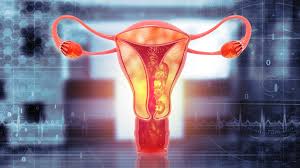Overview of Uterine Cancer
Uterine cancer, primarily affecting the endometrium, is the most common gynaecological cancer
worldwide. According to the Global Cancer Observatory, in 2020, there were over 417,000 new
cases globally, with approximately 97,000 deaths . In India, uterine cancer ranks among the top five
leading sites for cancers affecting women , with a rising incidence due to increasing life expectancy
and lifestyle changes. Early detection and awareness of its symptoms are crucial for effective
treatment and improved survival rates. The disease predominantly affects postmenopausal women,
but younger women can also be at risk, particularly those with certain genetic predispositions or
hormonal imbalances.
Understanding Uterine Cancer
Uterine cancer originates in the uterus, the pear-shaped organ where foetal development occurs.
The most common type, endometrial cancer, starts in the lining of the uterus (endometrium). Less
common types include uterine sarcoma, which develops in the muscles or other tissues of the
uterus. Risk factors for uterine cancer include obesity, diabetes, hypertension, and a history of
infertility. Hormone replacement therapy and certain genetic conditions, such as Lynch syndrome,
also increase risk. Understanding these risk factors is essential for prevention and early detection,
emphasizing the importance of regular medical check-ups and awareness of one’s medical history.
Early Warning Signs and Symptoms of Uterine Cancer
Recognizing the early warning signs of uterine cancer is vital for timely intervention. The most
common symptom is abnormal vaginal bleeding, which can manifest as postmenopausal bleeding,
bleeding between periods, or unusually heavy menstrual periods. Other symptoms include pelvic
pain, pain during intercourse, and an unusual discharge that may be watery or blood-tinged.
Additionally, unexplained weight loss and a feeling of a mass in the pelvic area can be indicative of
advanced disease. Early symptoms are often mistaken for less serious conditions, making it essential
to consult a healthcare provider if any unusual changes occur. Awareness and vigilance can lead to
earlier diagnosis and better treatment outcomes.
Seeking Timely Diagnosis
Timely diagnosis of uterine cancer significantly enhances treatment success and survival rates. The
diagnostic process typically begins with a thorough medical history and physical examination. If
uterine cancer is suspected, several tests may be conducted. A transvaginal ultrasound helps
visualize the uterus and detect abnormalities in the endometrial lining. An endometrial biopsy,
where a tissue sample is taken from the uterine lining, is crucial for confirming the presence of
cancer cells. Hysteroscopy, which involves inserting a camera into the uterus, allows for a detailed
examination and targeted biopsies. In some cases, imaging tests such as MRI or CT scans are used to
assess the spread of the cancer. Early diagnosis not only improves the chances of successful
treatment but also offers a wider range of treatment options, including surgery, radiation therapy,
and chemotherapy.
Conclusion
Uterine cancer, while a significant health concern, can be effectively managed with early detection
and appropriate treatment. Awareness of the early warning signs and proactive healthcare measures
are key to combating this disease. Regular medical check-ups and prompt consultation with
healthcare providers when symptoms arise can lead to early diagnosis and better outcomes. By
staying informed and vigilant, women can take control of their health and improve their chances of
overcoming uterine cancer.

Dr. Ayappan S Senior Consultant-Surgical Oncology





.png)




